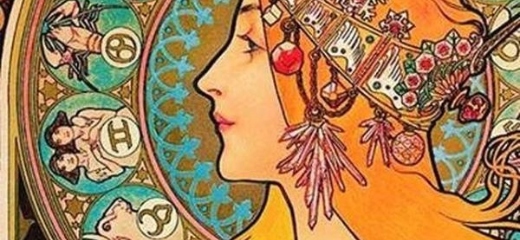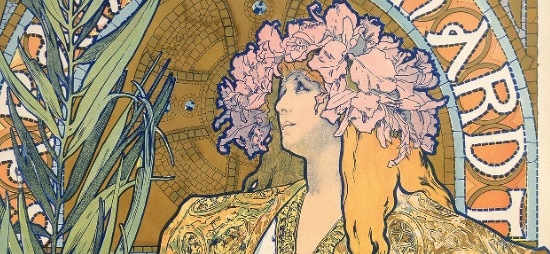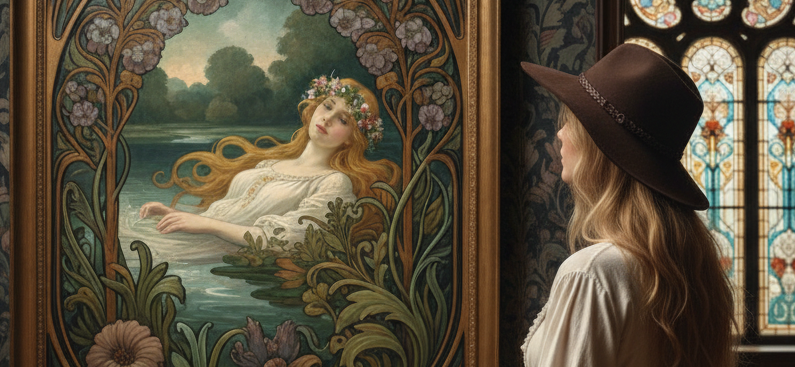Art Nouveau is a popular term for the variously named but closely related styles that had a pervasive impact on architecture, painting, and sculpture as well as applied design of every kind, from jewelry and typography to furniture and infrastructure. It burst onto the European scene around 1880, but soon it could be found everywhiere with its distinctive undulating lines, swirling excesses, and propulsive forms.
Compared to Art Deco, which only has one name, Art Nouveau makes it more complex. Test your skills in finding the differences between Art Deco and Art Nouveau by clicking here.
Since Art Nouveau became popular in various countries in Europe, the movement gained different regional and sometimes even local names. The most popular names are Art Nouveau, Jugendstil, Secession, Modernisme and Modernisme, but more names exist all over the world.
- Austria: Secessionstil, Sezessionstil, Secession, Sezession or Viennese Secession
- Belgium: Art Nouveau, Style coup de fouet, Paling Stijl, or Style nouille
- Britain: Modern Style
- Catalonia: Modernisme
- Czech Republic and Hungary: Secession or Secese
- Denmark: Skønvirke, Jugend or Jugendstil
- England: Tiffany Style, Style Liberty, Liberty Style or Modern Style
- Estonia: Juugend
- Finland: Kansallisromantiikka, Romantic Nationalism, Kalevala Style or Jugend
- France: Art Nouveau, Style Métro or Style Guirnard
- Germany: Jugendstil, Reformstil, Jugend, Secession, Viennese Secession, Wellenstil, Lilienstil or Reformstil
- Hungary: Hungarian Szecesszió
- Italy: Stile Floreale, Stile Liberty or just Liberty
- Japan: Shiro-Uma
- Latvia: Jugendstil, Jūgendstils
- Lithuania: Moderas
- The Netherlands: Paling Stijl, Slaoliestijl, Amsterdam School style, Niewe Kunst Nieuwe Kunst or Nieuwe Stijl
- Norway: Jugend, Jugendstil or Skønvirke
- Poland: Secesja, Young Poland or Nova Polska
- Portugal: Arte Nova
- Romania: Arta 1900, Arta Nouă, or Noul Stil
- Russia and Russian Empire: Stil Modern, Modern, Russian Модерн or Modern Style
- Scotland: Glasgow Style
- Serbia: Secession
- Slovakia: Secesia
- Slovenia:Secessionist style
- Spain and South America: Modernismo
- Sweden: Jugend, Nationalromantik or Swedish Art Nouveau
- Switzerland: Style sapin
- Ukraine: Art Nouveau
- US: Tiffany Style
Some people call other names like arte nouveau, art noveau, art nouvea or others, but these are only spelling mistakes 😉
These names identify similar styles that emerged in many countries at about the same time, mainly in Europe. You can also find Art Nouveau in the following countries:
- Algeria
- Argentina
- Armenia
- Australia
- Azerbaijan
- Belarus
- Brazil
- Chile
- China
- Costa Rica
- Croatia
- Cuba
- Dominican Republic
- Ecuador
- Estonia
- Finland
- Georgia
- Iceland
- Luxembourg
- Malta
- Mexico
- Moldova
- Morocco
- Namibia
- Peru
- Romania
- South Korea
- Switzerland
- Tunisia
- Turkey
- Uruguay
The 40 names of Art Nouveau: Amsterdam School style, Art Nouveau, Arte Nova Glasgow, Style Hungarian, Szecesszió, Jugend, Jugendstil, Kansallisromantiikka, Liberty Style, Lilienstil, Moderas, Modern Style, Modernisme, Modernismo, Nationalromantik, Niewe Kunst, Nova Polska, Paling Stijl, Reformstil, Romantic Nationalism, Russian Модерн, Secese, Secesia, Secesja, Secession, Secessionist style, Secessionstil, Sezession, Skønvirke, Slaoliestijl, Stil Modern, Stile Floreale, Style Guirnard, Style Liberty, Style Métro, Tiffany Style, Viennese Secession Wellenstil and Young Poland. Probably there are more names than those, if you have other namings please share with us so we can add to this list.
Victor Horta designed palaces for nouveau riche Belgian oligarchs. Its extraordinary applicability, from high art to utilitarian design was one of its innovative characteristics. This novel aesthetic caught on so completely because it presented modernism garbed in the raiment of pure pleasure, not the hair shirt of social obligation or moral uplift. It was also more than a bit vulgar and on occasion blatantly sexy, qualities that have never dampened mass appeal.
Plenty of names for an Art style that changed the world at the turn of the 19th into the 20th Centuries. Be inspired by the pre-war Art Nouveau Heritage in this site.
While Art Deco is commonly known by its singular name, Art Nouveau has been given over 40 different names, reflecting its diverse interpretations and influences across different countries and cultures. Art Nouveau emerged in the late 19th century as a reaction against the ornate, academic styles of the time and sought to incorporate natural forms and organic motifs into design and art. Its popularity spread rapidly across Europe and beyond, with each region and country imbuing their own unique cultural influences into the movement.
The diverse interpretations of Art Nouveau led to a variety of names being given to the movement, such as Jugendstil in Germany, Secession Style in Austria and Hungary, and Stile Liberty in Italy. Other variations include Modernismo in Spain, Modern Style in England, and Tiffany Style in the United States. These names reflect the unique characteristics and influences of Art Nouveau in each region, highlighting the movement’s ability to adapt and evolve in response to different cultural and social contexts.
In contrast, Art Deco emerged in the 1920s as a response to the austerity and severity of World War I and focused on sleek, geometric forms and streamlined designs. Its emphasis on luxury, glamour, and modernity quickly made it a popular style across the world, and it became known simply as Art Deco. Its singular name reflects its more unified, standardized approach compared to the varied interpretations and influences of Art Nouveau.
To learn how to differentiate between Art Nouveau and Art Deco works of art, readers can explore the following link: CLICK HERE. This resource provides a helpful guide on the distinguishing features of each style, such as the use of natural forms and flowing lines in Art Nouveau and the geometric shapes and metallic finishes of Art Deco. Additionally, the link provides examples of furniture, jewelry, and other decorative objects from each style, allowing readers to compare and contrast the differences between them.
By studying the unique characteristics and influences of each style, readers can develop a deeper understanding and appreciation for the art movements that have shaped our cultural heritage. Whether it’s recognizing the flowing, floral patterns of Art Nouveau or the bold, streamlined designs of Art Deco, understanding the nuances of each style can enrich our experiences with art and design.
The global enthusiasm for the swirling, organic style of Art Nouveau gave rise to a stunning proliferation of names, reflecting not just regional differences but also the inherent difficulty in translating a distinctive aesthetic into a single, consistent term. While the style is known by its official designation, the sheer variety of spellings and misspellings that emerged across cultures highlights a core challenge in popular adoption: a new, complex concept often gets rendered phonetically or creatively by those adopting it. Beyond the widely accepted terms like Jugendstil (Germany), Sezessionstil (Austria), and Modern Style (Britain), the style spawned numerous vernacular variations. These include attempts to capture the original French pronunciation, as well as simple phonetic errors that persisted across decades of non-standardized print.
The vast list of alternative spellings—well over 40 distinct variations—demonstrates the style’s widespread diffusion and popular recognition, even if the spelling was mangled in the process. Some of the most common phonetic or erroneous variants include: artnovo, artnouvou, arnouveau, artnouvo, artnovou, art nouveau, art noveau, art nooveau, artnuvo, artnuvou, artnou and artnouvaeu. This extensive lexical variance is, in a way, a testament to the style’s cultural impact, showing that even if people couldn’t agree on the proper spelling, they knew the revolutionary aesthetic it represented. The very act of attempting to capture the phrase “Art Nouveau” in print, across multiple languages and historical periods, guaranteed a rich and sprawling list of creative misnomers
By understanding the differences between Art Nouveau and Art Deco (click HERE), you can better appreciate the unique characteristics of each art movement. So click here to learn more!





